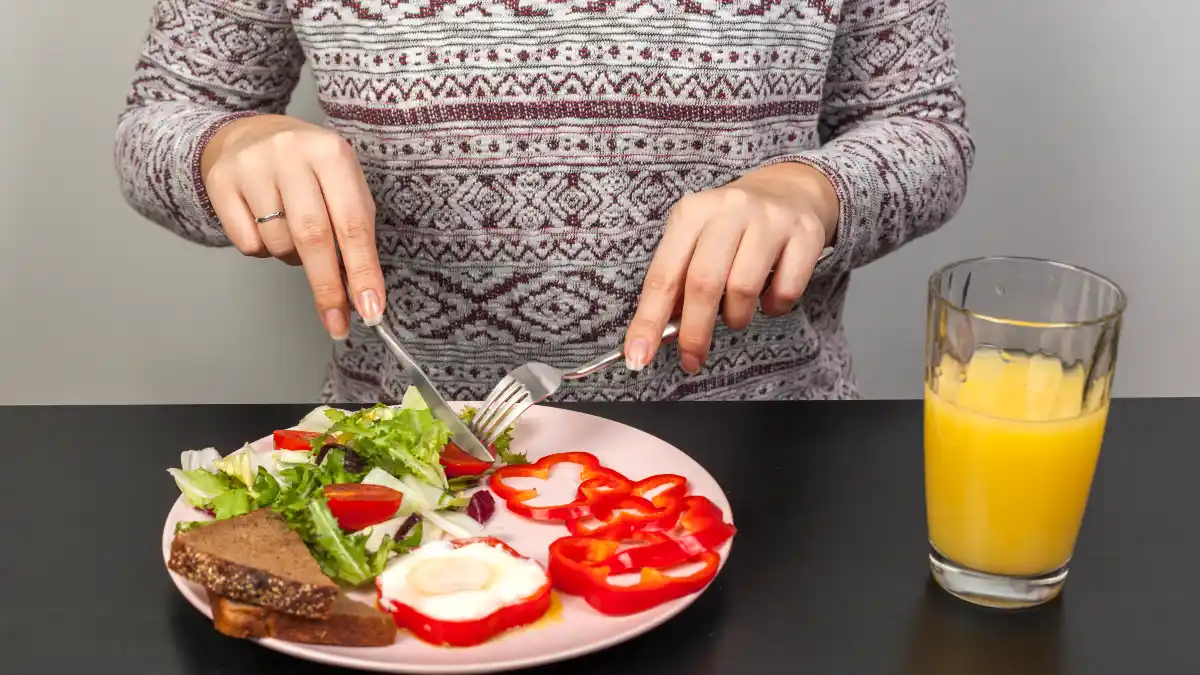Your digestive system feels like an unpredictable enemy. One day a food is fine; the next, it leaves you bloated, tired, and mentally foggy.
This constant guessing game is exhausting, and the standard advice to just “eliminate” foods feels like a life sentence of restriction. This isn’t just in your head; it’s a sign your gut is struggling. What if you could find clarity without a crazy diet?
This guide presents a different path: a powerful, short-term plan to help your body heal from the inside out. By giving your gut a 72-hour break, you can calm the inflammation causing your food sensitivities and finally learn what your body truly needs. This is your path to food freedom, not food fear.
Why Does Food Make You Feel Bad?

The Growing Problem of Food Frustration
Does eating sometimes feel like a guessing game? You have a meal and end up with bloating, brain fog, or feeling tired for no reason. For millions of people, the simple act of eating has become stressful.
This isn’t just in your head. It’s a real and growing problem. A large number of people in the Western world report having bad reactions to food.
In the United States, almost one in four adults says they have a food intolerance. This is different from a true food allergy, which is much rarer and can be life-threatening.
This leaves many people in a tough spot. You have real symptoms, but it’s not a classic allergy. The problem isn’t a dangerous immune reaction. It’s a sign that your digestive system is struggling.
For a long time, the main advice has been to try an elimination diet. This means you stop eating common trigger foods like gluten or dairy to see what’s causing the problem. These diets can sometimes help, but they are hard to follow.
They can be tough on your social life and make you worry about every meal. Plus, they focus on avoiding foods instead of fixing the reason your body started overreacting in the first place.
This guide offers a different way. It shows you a powerful, short-term plan to help your body heal. The goal is not to restrict food forever. First, you restore your gut health. Then, you can clearly see which foods are your personal triggers.
By giving your body a 72-hour break, you can calm down the inflammation that causes food sensitivities. This gives you a chance to reintroduce foods and learn what your body truly needs. It’s a path to food freedom, not food fear.
Why Your Gut Is Overreacting to Food
To figure out why certain foods cause problems, you need to look at your gut. The issue is usually not the food itself. It’s how your body is handling that food.
Your gut is home to trillions of tiny helpers like bacteria and fungi. This community is called the gut microbiome. When it’s healthy and diverse, it helps you digest food, absorb nutrients, and supports your immune system.
But modern life can throw it off balance. Things like processed foods, sugar, stress, and poor sleep can disrupt this delicate system. This imbalance is called dysbiosis.
Dysbiosis can cause low-level inflammation that damages the lining of your intestines. Think of your gut lining as a strong fence. It’s supposed to let good things (like nutrients) pass into your bloodstream and keep bad things (like undigested food and toxins) out. When the fence gets damaged, it develops holes. This is often called “leaky gut.”
This leakage is where the trouble starts. When bits of undigested food get through the “fence” and into your bloodstream, your immune system sees them as invaders.
It attacks them, causing more inflammation. If this happens over and over, your immune system might start reacting to common foods like gluten or dairy.
This isn’t a true allergy, but a food sensitivity. It causes delayed symptoms like bloating, headaches, joint pain, and fatigue.
The problem isn’t the food, but the leaky gut that lets the food get to the wrong place.
This changes everything. Instead of just avoiding the foods that trigger you, a better long-term plan is to repair the gut itself. That is the main goal of a 72-hour fast.
The Science of the 3-Day Reset

What a 72-Hour Break Does for Your Gut
A 72-hour fast isn’t a random number. Science shows that this is when your body switches from just saving energy to deep repair mode. Giving your digestive system a complete break for three days starts powerful processes that fix the root causes of food sensitivity.
One of the most important things that happens is cellular autophagy. This sounds complex, but it’s just your body’s cleanup crew. During autophagy, your cells break down and recycle old, damaged parts.
Think of it as spring cleaning for your body. After 72 hours of a water-only fast, this cleanup process gets a major boost. This helps reduce inflammation by clearing out the junk that makes your immune system overreact.
At the same time, the fast gives your gut lining a chance to heal. The cells that line your gut renew themselves about every 72 hours. Normally, they have to do this while dealing with the stress of constant digestion.
A 72-hour fast gives them an uninterrupted window to repair the “fence,” making your gut barrier stronger.
Recent research also shows that after three days, your whole body gets a reset. A study found that after about 72 hours of fasting, major changes happen to proteins in all your main organs. This shows that it’s not just a rest for your gut; it’s a full-body tune-up that recalibrates how your cells work.
Finally, this break has a big impact on your gut microbiome. Fasting can lower inflammation in the gut and help good bacteria grow.
By cutting off the food supply to the microbes that love sugar and processed carbs, you help shift the balance in favor of the good guys.
These four benefits—the cleanup crew, gut repair, a full-body reset, and a healthier microbiome—all come together around the 72-hour mark. This is why a three-day fast can be a powerful tool to reset your digestive and immune health.
What This Gut Reset Is (and What It Isn’t)
While a 72-hour fast has real benefits, the term “gut reset” can be confusing. It’s important to know what this plan can and can’t do.
First, this is not a commercial “cleanse” or “detox.” You won’t be drinking expensive juices to get rid of vague “toxins.” The goal is to use your body’s own natural repair systems, like autophagy, by giving it a complete break from digestion.
As one gastroenterologist put it, a real reset is about “stopping the bad exposures and improving the healthy exposures,” not a magic purge.
Second, a 72-hour reset is not a permanent fix. Your gut microbiome can change quickly, but those changes might not last if you go back to old habits.
Think of the fast as a powerful start, not a one-time cure. It opens a window of opportunity. What you do after the reset is what matters for long-term health.
Also, the idea of “starving bad bacteria” is a bit of an oversimplification. While cutting off sugar does help, the main benefit of the fast is how it heals your body.
It repairs the gut lining and calms the immune system. This creates a healthier place for good bacteria to live.
The real power of this short break is that it creates a state of low inflammation and high awareness. The fast is like putting on noise-canceling headphones for your body. It quiets the static of digestive stress so you can finally hear your body’s signals clearly.
After the fast, you might feel more sensitive to certain foods. This isn’t a bad sign; it’s a sign of clarity. You can use this unique opportunity to learn which foods truly work for you and which don’t.
Your Guide to the 72-Hour Gut Reset

The Blueprint: A Day-by-Day Plan
Here is a 5-day plan to guide you through the 72-hour gut reset safely. It includes one day to prepare, three days for the water-only reset, and one day to gently reintroduce food.
Wait! Is this safe for you? Read this first.
This plan is for healthy adults. It is not for you if you are pregnant or breastfeeding, have a history of eating disorders, are underweight, or have medical conditions like type 1 diabetes. Please talk to your doctor before starting this or any major diet change.
| Day/Phase | Time of Day | What to Do (Food, Drink, Activity) | Why It Helps |
| Day 0: Get Ready | All Day | Stop eating processed foods, sugar, refined carbs, alcohol, and caffeine. Eat whole plant foods like vegetables, fruits, and beans. Eat smaller meals than you normally would. | This helps your body get ready for the fast and makes it easier. |
| Evening | Have a light, early dinner. Focus on cooked vegetables with a little bit of lean protein or beans. | A light last meal is easier on your digestive system as it prepares to rest. | |
| Day 1: Reset | All Day | Drink only water. Aim for 2-3 liters, or just drink when you’re thirsty. You can add a pinch of sea salt for electrolytes. No other drinks or food. | This keeps you hydrated while letting your gut rest completely. The healing process begins. |
| All Day | Do only light activity. Gentle walking or stretching is fine. Avoid intense exercise like running or lifting weights. | This keeps your body moving gently without adding extra stress. | |
| All Day | Rest as much as you can. Take naps if you feel like it. Try meditating, deep breathing, or a warm bath. | Stress is bad for your gut. Relaxing helps your body heal and can make hunger easier to manage. | |
| Day 2: Reset | All Day | Keep drinking only water, just like on Day 1. | Your body is now burning fat for fuel. The cellular cleanup crew (autophagy) is starting to work hard. |
| All Day | Continue with light activity and rest. Pay attention to your energy levels and listen to your body. | This saves energy so your body can focus on repair. It’s normal to feel tired but also mentally clear. | |
| Day 3: Reset | All Day | Continue with only water. This is your last 24 hours. | You’ve reached the 72-hour mark. The biggest benefits of the fast are kicking in now. |
| All Day | Keep up the light activity and rest. Get ready to break your fast tomorrow. | Staying calm is key for healing. Thinking about how you’ll reintroduce food helps you do it carefully. | |
| Day 4: Break the Fast | Morning (First “Meal”) | About 30 minutes before you eat, drink a glass of water with a little lemon juice or apple cider vinegar. | This gently wakes up your digestive system. |
| Morning (First “Meal”) | Have 1-2 cups of plain bone broth or a simple vegetable broth. Sip it slowly. | This gives your body easy-to-absorb nutrients and soothes your gut. | |
| Afternoon (Second “Meal”) | Eat a small amount of soft, cooked foods. Think vegetable soup, steamed zucchini, or stewed apples. Avoid raw veggies, nuts, dairy, and grains for now. | This reintroduces gentle fiber and nutrients that are easy for your rested gut to handle. | |
| Evening (Third “Meal”) | Have another small, well-cooked meal like your afternoon one. Keep drinking plenty of water. | This continues to gently wake up your digestive system. |
Section 6: How to Become Your Own Food Detective
The time right after the reset is the most important part. This is where you can figure out your food sensitivities without a long, difficult elimination diet. Your body is now in a state of high alert, and you can use this to your advantage.
Here’s the idea: after a 72-hour break, the inflammation that causes your usual symptoms is much lower.
Your gut lining is healthier, and your immune system is calmer. In this quiet state, your body’s reaction to a food is much clearer. A food that used to cause vague symptoms might now give you a very clear signal.
To do this right, you need to be patient and methodical. The plan is to reintroduce potential trigger foods one by one and watch how your body reacts.
Keep a journal. For each new food, write down the date, time, how much you ate, and any symptoms you feel over the next day or two. Pay attention to everything: bloating, gas, headaches, fatigue, skin issues, or mood changes.
Here is a sample schedule, starting after Day 4:
- Day 5: Stick to Safe Foods. Eat the same easy-to-digest foods from Day 4, like cooked vegetables and broth. You could add a small piece of poached chicken or fish. This sets your new baseline.
- Day 6: Test a Gluten-Free Grain. Add one serving of something simple, like plain quinoa or white rice. Eat it with your safe foods. Watch for any reaction for 24-48 hours.
- Day 7: Test Dairy. If the grain was fine, try one serving of a simple dairy product, like plain, full-fat yogurt. Watch for any reaction for 24-48 hours.
- Day 8: Test Gluten. If dairy was okay, try one serving of a whole-food source of gluten, like a slice of good sourdough bread. Watch for any reaction for 24-48 hours.
- After That: Continue this process with other foods you think might be a problem, like eggs, soy, or nuts. Always introduce only one new food at a time.
This process is powerful. Instead of following a generic list of “bad” foods, you are creating your own personalized data.
The food choices you make after this are based on your own experience. This is the key to a sustainable way of eating that is built on knowing your body, not on feeling deprived. This is the path to true food freedom.
How to Build a Strong Gut for Life

How to Keep Your Gut Healthy for Good
The 72-hour reset is a great start, but what you do next is what really counts. The goal is to build a gut that is strong and healthy for the long run. The best ways to do this are simple and backed by science.
The most important thing you can do is eat a wide variety of foods. A diverse diet leads to a diverse and healthy community of gut microbes. A great goal is the “30-Plant Rule.” Try to eat 30 different types of plant foods each week.
This includes fruits, vegetables, whole grains, beans, nuts, seeds, and spices. Each plant feeds different types of good bacteria, making your gut ecosystem strong.
Fiber is key. It’s not just “roughage”; it’s the main food for your good gut bacteria. When they eat fiber, they produce healthy compounds that fuel the cells of your gut lining and reduce inflammation.
It’s also a good idea to add fermented foods to your diet. Foods like kefir, kimchi, sauerkraut, and plain yogurt contain live probiotic bacteria. These can help boost the good bacteria in your gut.
Beyond food, a healthy gut depends on a healthy lifestyle.
- Get Good Sleep: Your gut microbes have a daily rhythm, just like you do. Not getting enough sleep can throw them off. Aim for 7-9 hours of quality sleep each night.
- Move Your Body: Exercise can increase the diversity of your gut microbes. Regular, moderate activity like walking or yoga also helps with digestion and can reduce bloating.
- Manage Stress: Your gut and brain are always talking to each other. Chronic stress can harm this connection and lead to a leaky gut. Things like meditation, deep breathing, or spending time in nature are great for managing stress and supporting your gut.
Finally, try to limit things that are known to harm the gut. This includes ultra-processed foods, added sugars, and artificial sweeteners, which can feed the wrong kind of microbes and cause inflammation.
You don’t have to be perfect. It’s about making choices that support a healthy gut most of the time. The 72-hour reset gives you a clean slate, making it easier to build these healthy habits for life.
From a 3-Day Reset to a Lifetime of Food Freedom
The rise in food sensitivities shows that our relationship with food and our bodies is out of balance. For too long, the focus has been on blaming specific foods, which leads to fear and anxiety around eating.
But science shows us that the problem is often a damaged gut and an overactive immune system.
This guide has shown you a powerful, science-based alternative to endless elimination diets.
The 72-hour gut reset uses your body’s own healing powers to calm inflammation and repair your gut. It’s not a quick fix, but a strategic pause that resets the conversation between your gut, your immune system, and your brain.
The real magic happens in the days that follow. By reintroducing foods carefully, you can become an expert on your own body. This process replaces confusion with clarity and helps you create a way of eating that is perfect for you.
The ultimate goal is not to live a life of restriction. It’s to build a gut so healthy and strong that it can handle a varied and joyful diet.
The 72-hour reset can unlock that potential. It’s a short-term plan that can lead to a lifetime of knowing your body, feeling great, and eating with confidence.


